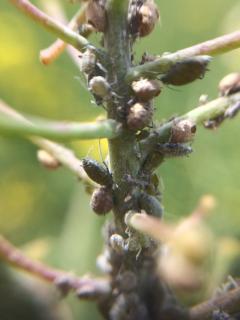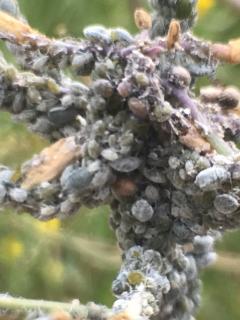Aphids are active in canola, lupins, vetches and lentils
Canola aphids
- Toodyay
- Northam
- Mayanup
- Jerramungup
- Grass Patch
- Scaddan
- Gibson
Crop protection officer Bec Swift (DPIRD) has reported finding cabbage aphids in canola (variety unknown) near Toodyay. Some of the aphids were parasitised by wasps. One to 10% of branches were infested.
Ben Creek (AGRIvise) reports that cabbage aphids are present in late flowering Stingray canola near Mayanup. Up to 10% of branches were infested.
Plant virologist Ben Congdon (DPIRD) reports seeing lots of green peach aphids (GPA) in podding canola in Northam and Jerramungup areas. There is also a lot of cabbage aphids in podding canola in the Northam area. Ben also reports that GPA are migrating from canola to pulses at Grass Patch, Scaddan and Gibson.
If more than 20% of plants are infested with colonies of cabbage or turnip aphids, control measures should be considered to avoid yield losses. Green peach aphids do not usually cause economic damage to advanced canola crops unless the plants are already experienced significant moisture stress. Growers are advised that cabbage aphids are often aggregated along crop edges and it is important to monitor and not overestimate them from isolated hotspots. The risk of economic yield losses to aphids is increased if canola crops are already under some degree of moisture stress or experience poor finishing rains.
For more information on identifying and managing canola aphids refer to the department’s;
- Aphid management in canola crops page
- Diagnosing canola aphids page
- 2017 Protecting WA Crops Issue 3 newsletter Aphids – WA’s insect problem children
- Aphids in your crops YouTube video.
Aphids in lupins, vetches and lentils
- Nunile
- Grass Patch
- Scaddan
- Gibson
Plant virologist Ben Congdon (DPIRD) reports finding a light colonisation of cowpea and blue green aphids in flowering lupins near Nunile.
Ben also reports that there a large numbers of cowpea aphids (some parasitised) in vetches and lentils at Grass Patch, Scaddan and Gibson.
The three most common aphid species which attack lupins are cowpea aphid, bluegreen aphid and green peach aphid.
Cowpea aphids are usually easily spotted by their black colour and dense clusters on a few plant growing points. On close inspection with a magnifying lens their black and white legs are also a good identification feature.
The bluegreen aphid is the largest of the three common species, measuring up to 3mm long. Both the winged and wingless forms are a matte bluish-green, similar in colour to the mature leaves of narrow-leaf lupins.
The green peach aphid (GPA) tends to be shiny or waxy and ranges from yellow, through to green and pink in colour. The yellowy-green GPAs are similar in colour to young unfurled lupin leaves. The winged GPAs have a dark patch on their backs.
Aphids can damage lupin crops through both feeding damage and virus transmission (cucumber mosaic virus and bean yellow mosaic virus).
The spray threshold for control of aphids on lupins is for more than 30% of flowering spikes to have 30 or more aphids. Consideration should also be given to potential crop yield.
For more information refer to DPIRD’s Identification of aphids in lupin crops and Management of aphids in Western Australian lupin crops pages.
For a list of insecticides registered for use on aphids see the department’s 2018 Winter/Spring Insecticide Guide.
For more aphid information contact Dustin Severtson, Development Officer, Northam on +61 (0)8 9690 2160 or Alan Lord, Technical Officer, South Perth on +61 (0)8 9368 3758 or Svetlana Micic, Research Officer, Albany on +61 (0)8 9892 8591.


